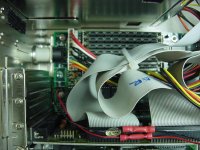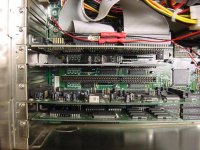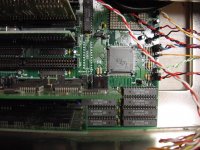Welp, I found this replacement battery on fleabay They're brand new and sold by Radio Shack, so it's for a good cause.. 
I had to remove the motherboard on my mini-tower AMD 386 @ 40Mhz. The ni-cad was mounted too tight to surroundings to snip. I wasn't looking forward to ruffling the feathers on this venerable old bird. The push pins mounting the board gave me some trouble, but I had spares. Once I got the board out, I followed the usual instructions of adding a little new solder to the pin, then soaking it up with copper braid, then prying out with solder iron on each side. My battery also had the glue blob. I noticed that the battery connector (which was a four pin setup) had one dead hole to make sure you oriented it correctly. My mobo has all 4 pins on the header, unfortunately. It is also not marked what is Pos. Neg. So I tried my luck and bent down 1 of the middle pins and snipped it out. Buttoned things up and turned on. Nope. Low battery error message. Re-opened, bent down other pin and snipped. Made a note inside the case about which way the plug must go. Buttoned up again, turned on, Success!! Checked all peripherals, network, memory, Windows, programs, etc. Everything is good. I guess the old bird is tougher than I thought. I checked again after leaving off for about 20 mins. Will keep checking after a couple of days of being off. I like the fact that the Lithium has the correct original voltage, and supposedly should last for a long time.
With the ni-cad I had to be sure to turn pc on every week or so to charge it up. It was losing about 5-10 minutes every few days. Still surprising how long it lasted (21 yrs.) without leaking, and staying usable. The pc sat unused for about 13 yrs. straight in my basement before being re-discovered a year or two ago.
Very glad this job is done! Now I can worry about the capacitors instead... :wow:
I had to remove the motherboard on my mini-tower AMD 386 @ 40Mhz. The ni-cad was mounted too tight to surroundings to snip. I wasn't looking forward to ruffling the feathers on this venerable old bird. The push pins mounting the board gave me some trouble, but I had spares. Once I got the board out, I followed the usual instructions of adding a little new solder to the pin, then soaking it up with copper braid, then prying out with solder iron on each side. My battery also had the glue blob. I noticed that the battery connector (which was a four pin setup) had one dead hole to make sure you oriented it correctly. My mobo has all 4 pins on the header, unfortunately. It is also not marked what is Pos. Neg. So I tried my luck and bent down 1 of the middle pins and snipped it out. Buttoned things up and turned on. Nope. Low battery error message. Re-opened, bent down other pin and snipped. Made a note inside the case about which way the plug must go. Buttoned up again, turned on, Success!! Checked all peripherals, network, memory, Windows, programs, etc. Everything is good. I guess the old bird is tougher than I thought. I checked again after leaving off for about 20 mins. Will keep checking after a couple of days of being off. I like the fact that the Lithium has the correct original voltage, and supposedly should last for a long time.
With the ni-cad I had to be sure to turn pc on every week or so to charge it up. It was losing about 5-10 minutes every few days. Still surprising how long it lasted (21 yrs.) without leaking, and staying usable. The pc sat unused for about 13 yrs. straight in my basement before being re-discovered a year or two ago.
Very glad this job is done! Now I can worry about the capacitors instead... :wow:




